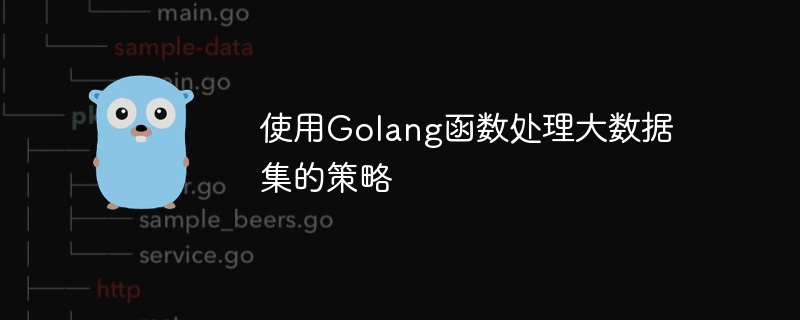使用Golang函数处理大数据集的策略
在 Golang 中处理大数据集时,有效运用函数式特性至关重要,高阶函数(map、filter、reduce)可高效操作集合。此外,并发处理(goroutine 和 sync.WaitGroup)和流式处理(channel 和 for-range 循环)也有效提高处理效率。

使用 Golang 函数处理大数据集的策略
在处理大数据集时,采用适当的函数式编程策略至关重要。Golang 提供了强大的函数式特性,使你能够有效地管理和操作大数据。
使用通用的高阶函数
-
map: 将函数应用于集合中的每个元素,产生一个新集合。 -
filter: 过滤集合,产生一个满足给定断言的新集合。 -
reduce: 累积集合中的元素,生成一个汇总值。
// 高阶函数处理大整数:
ints := []int{1, 2, 3, 4, 5}
// 映射:将每个元素平方
squaredInts := map(ints, func(i int) int { return i * i })
// 过滤:选择奇数元素
oddInts := filter(ints, func(i int) bool { return i % 2 != 0 })
// 归约:求总和
total := reduce(ints, func(a, b int) int { return a + b }, 0)并发处理
goroutine: 并发执行函数的轻量级线程。sync.WaitGroup: 协调并等待多个 goroutine 完成。
// 并发处理列表:
list := []Item{...} // 假设Item结构代表大数据集中的一个项目
// 创建 goroutine 数组
goroutines := make([]func(), len(list))
// 使用 goroutine 并发处理列表
for i, item := range list {
goroutines[i] = func() {
item.Process() // 调用项目专属的处理函数
}
}
// 使用 WaitGroup 等待所有 goroutine 完成
var wg sync.WaitGroup
wg.Add(len(goroutines))
for _, g := range goroutines {
go func() {
defer wg.Done()
g()
}()
}
wg.Wait()流式处理
channel: 用于并行传递数据的通信机制。for-range循环:用于从通道中读取数据。
// 使用通道进行流处理:
// 大数据集的通道
dataChan := make(chan Item)
// 读取通道并处理数据
for item := range dataChan {
item.Process()
}
// 在 goroutine 中生成数据并发送到通道
go func() {
for item := range list {
dataChan <- item
}
close(dataChan) // 完成数据发送时关闭通道
}()通过利用这些策略,你可以有效地处理 Golang 中的大数据集,提高应用程序的性能和可伸缩性。
以上是使用Golang函数处理大数据集的策略的详细内容。更多信息请关注PHP中文网其他相关文章!

热AI工具

Undresser.AI Undress
人工智能驱动的应用程序,用于创建逼真的裸体照片

AI Clothes Remover
用于从照片中去除衣服的在线人工智能工具。

Undress AI Tool
免费脱衣服图片

Clothoff.io
AI脱衣机

AI Hentai Generator
免费生成ai无尽的。

热门文章

热工具

记事本++7.3.1
好用且免费的代码编辑器

SublimeText3汉化版
中文版,非常好用

禅工作室 13.0.1
功能强大的PHP集成开发环境

Dreamweaver CS6
视觉化网页开发工具

SublimeText3 Mac版
神级代码编辑软件(SublimeText3)

热门话题
 突破或从Java 8流返回?
Feb 07, 2025 pm 12:09 PM
突破或从Java 8流返回?
Feb 07, 2025 pm 12:09 PM
Java 8引入了Stream API,提供了一种强大且表达力丰富的处理数据集合的方式。然而,使用Stream时,一个常见问题是:如何从forEach操作中中断或返回? 传统循环允许提前中断或返回,但Stream的forEach方法并不直接支持这种方式。本文将解释原因,并探讨在Stream处理系统中实现提前终止的替代方法。 延伸阅读: Java Stream API改进 理解Stream forEach forEach方法是一个终端操作,它对Stream中的每个元素执行一个操作。它的设计意图是处
 Java程序查找胶囊的体积
Feb 07, 2025 am 11:37 AM
Java程序查找胶囊的体积
Feb 07, 2025 am 11:37 AM
胶囊是一种三维几何图形,由一个圆柱体和两端各一个半球体组成。胶囊的体积可以通过将圆柱体的体积和两端半球体的体积相加来计算。本教程将讨论如何使用不同的方法在Java中计算给定胶囊的体积。 胶囊体积公式 胶囊体积的公式如下: 胶囊体积 = 圆柱体体积 两个半球体体积 其中, r: 半球体的半径。 h: 圆柱体的高度(不包括半球体)。 例子 1 输入 半径 = 5 单位 高度 = 10 单位 输出 体积 = 1570.8 立方单位 解释 使用公式计算体积: 体积 = π × r2 × h (4
 从前端转型后端开发,学习Java还是Golang更有前景?
Apr 02, 2025 am 09:12 AM
从前端转型后端开发,学习Java还是Golang更有前景?
Apr 02, 2025 am 09:12 AM
后端学习路径:从前端转型到后端的探索之旅作为一名从前端开发转型的后端初学者,你已经有了nodejs的基础,...
 如何在Spring Tool Suite中运行第一个春季启动应用程序?
Feb 07, 2025 pm 12:11 PM
如何在Spring Tool Suite中运行第一个春季启动应用程序?
Feb 07, 2025 pm 12:11 PM
Spring Boot简化了可靠,可扩展和生产就绪的Java应用的创建,从而彻底改变了Java开发。 它的“惯例惯例”方法(春季生态系统固有的惯例),最小化手动设置
 Go语言中哪些库是由大公司开发或知名的开源项目提供的?
Apr 02, 2025 pm 04:12 PM
Go语言中哪些库是由大公司开发或知名的开源项目提供的?
Apr 02, 2025 pm 04:12 PM
Go语言中哪些库是大公司开发或知名开源项目?在使用Go语言进行编程时,开发者常常会遇到一些常见的需求,�...
 VSCode中如何解决Golang泛型函数类型约束被自动删除的问题?
Apr 02, 2025 pm 02:15 PM
VSCode中如何解决Golang泛型函数类型约束被自动删除的问题?
Apr 02, 2025 pm 02:15 PM
VSCode中Golang泛型函数类型约束的自动删除问题在使用VSCode编写Golang代码时,用户可能会遇到一个奇怪的问题。当...
 Java程序将元素插入堆栈的底部
Feb 07, 2025 am 11:59 AM
Java程序将元素插入堆栈的底部
Feb 07, 2025 am 11:59 AM
堆栈是遵循LIFO(最后,首先)原理的数据结构。换句话说,我们添加到堆栈中的最后一个元素是第一个要删除的元素。当我们将(或推)元素添加到堆栈中时,它们就会放在顶部;即最重要的







